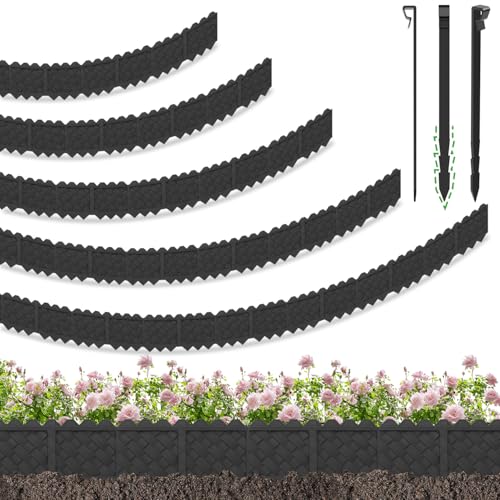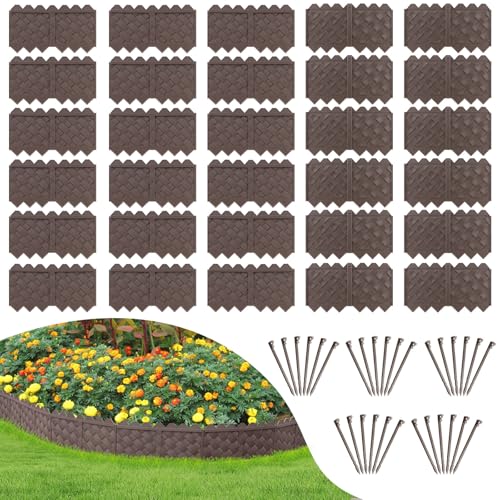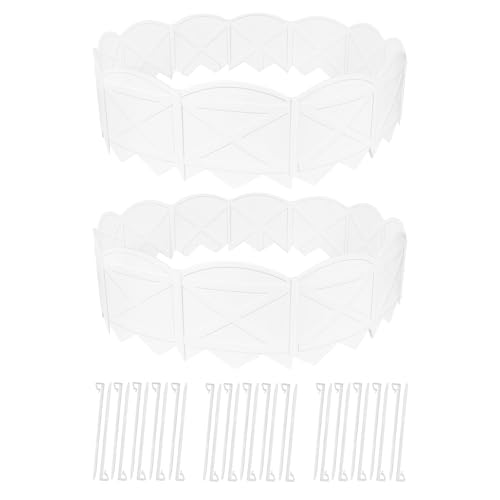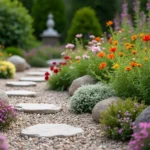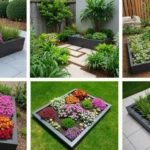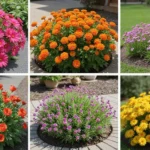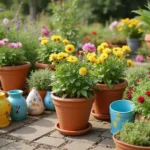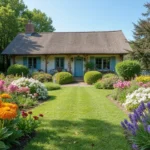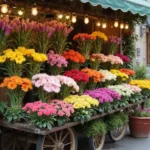Flower borders can transform a garden into a visual delight, making it feel more inviting and polished.
In cottage-style flower border gardens, the essence of nature meets creativity, creating vibrant spaces that bloom with color and charm. These borders not only enhance the landscape but also serve as a beautiful backdrop to your home, offering a warm welcome from the street. With an array of designs to inspire your gardening journey, you can capture the whimsical spirit of a cottage garden right in your backyard. Let’s explore over 30 delightful flower border ideas that will elevate your outdoor space into a stunning floral masterpiece.
1. Classic English Cottage Border
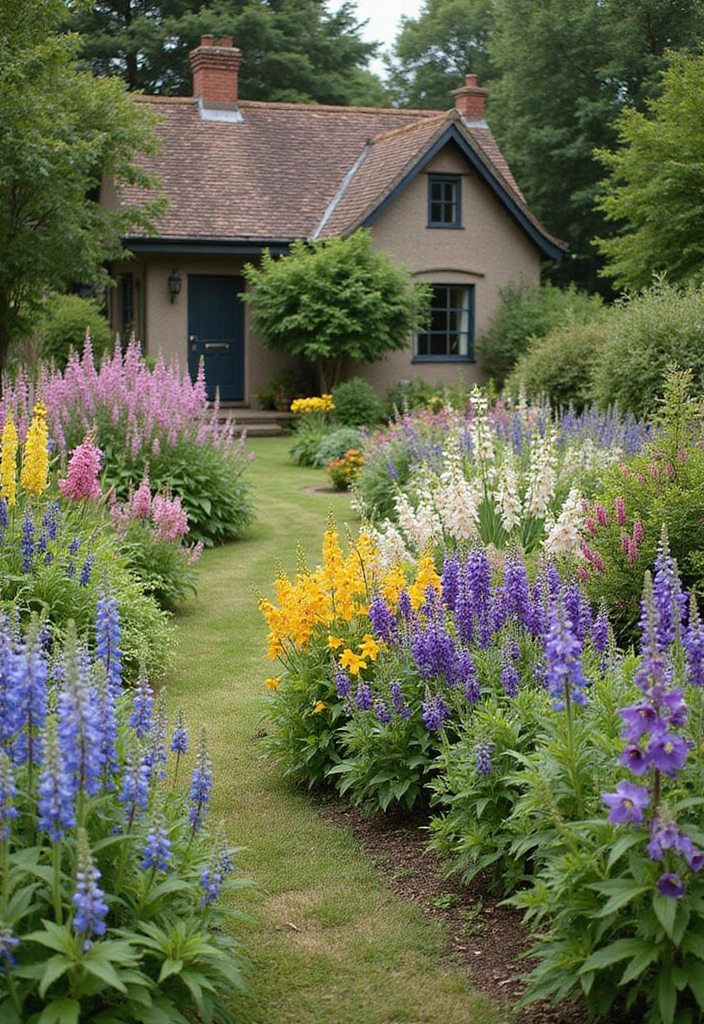
A classic English cottage border is characterized by a dense planting of flowers that creates a lush, romantic appearance.
Begin with a foundation of perennials like delphiniums, peonies, and foxgloves for height and structure. Layer in shorter flowers like lavender, salvia, and heuchera for texture and color. This design not only provides a variety of blooms from spring to fall but also invites pollinators into your garden. For added charm, intersperse some decorative stones or rustic wooden trellises to enhance the cottage feel.
Tips: Choose a mix of bloom times to ensure color throughout the seasons.
Trick: Add a few climbing plants such as climbing roses or wisteria against a wall or fence to create a dramatic backdrop. This will frame your flower border beautifully and add even more visual interest.
2. Low-Maintenance Perennial Border

For those who prefer easy-care gardening, a low-maintenance perennial border is an excellent choice.
Select hardy perennials such as sedum, daylilies, and coreopsis that require minimal attention yet offer stunning blooms. Arrange them in clusters to create a natural look while also ensuring there’s enough room for each plant to thrive. Incorporate ornamental grasses like miscanthus or blue fescue to add movement and texture without demanding extra care. This design is perfect for busy gardeners who want a polished look without the effort.
Unique Insight: Consider using mulch around your plants to suppress weeds and retain moisture, making your garden even more low-maintenance.
Suggestion: For seasonal interest, choose a few varieties with different flowering times to maintain color throughout the growing season.
3. Colorful Border with Annuals

If you want to make a bold statement, consider a border packed with colorful annuals.
Flowers such as marigolds, zinnias, and petunias offer a vibrant palette that can be changed each year for fresh looks. These plants thrive in sunny spots and produce abundant blooms throughout the growing season. Create a pattern with contrasting colors for an eye-catching design or choose a monochromatic scheme for a more sophisticated feel. The flexibility of using annuals means you can experiment with different combinations every year!
Tip: Group flowers by color to create a striking visual effect, and don’t forget to deadhead them regularly to keep them blooming longer.
Trick: Incorporate some decorative garden stakes or fairy lights to add an enchanting touch at night.
4. Mixed Flower and Shrub Border
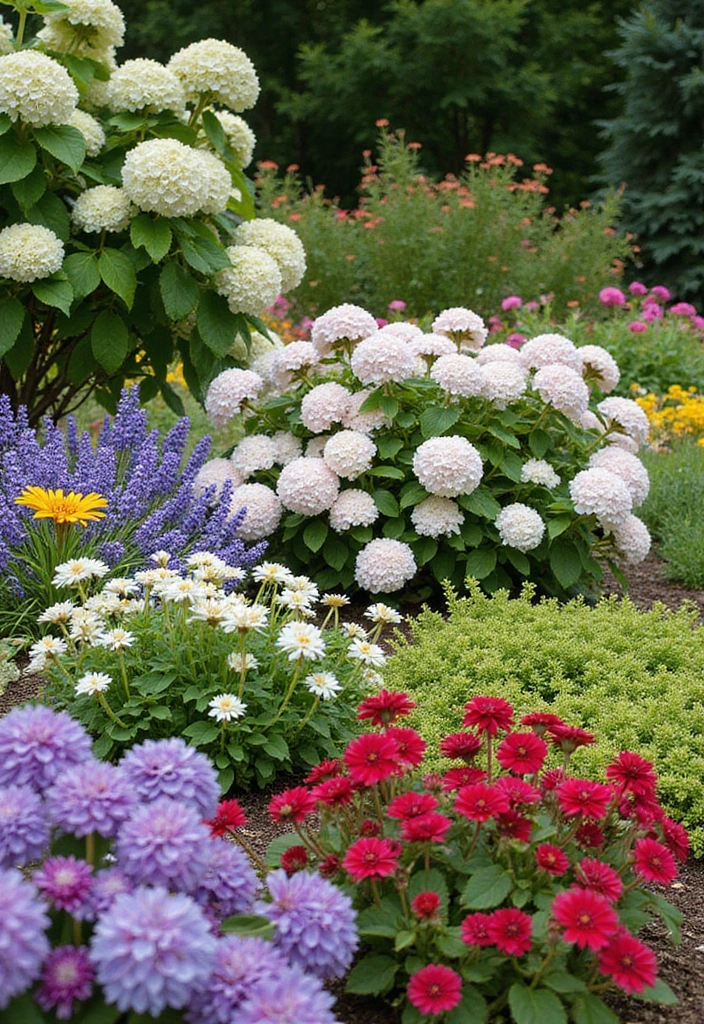
Combining flowers with shrubs creates a layered effect that adds depth and structure to any garden border.
Choose flowering shrubs such as hydrangeas, lilacs, or roses as the backbone of your design. Complement these with seasonal flowers like asters or coneflowers that can fill in the spaces and provide seasonal color. This approach allows you to enjoy blooms from spring through fall, creating a rich tapestry of colors and textures.
Insight: Use the natural height of shrubs to frame your flower border, leading the eye along the garden’s edge.
Suggestion: Incorporate some evergreen shrubs for winter interest, maintaining a polished look even in colder months.
5. Herb and Flower Combination
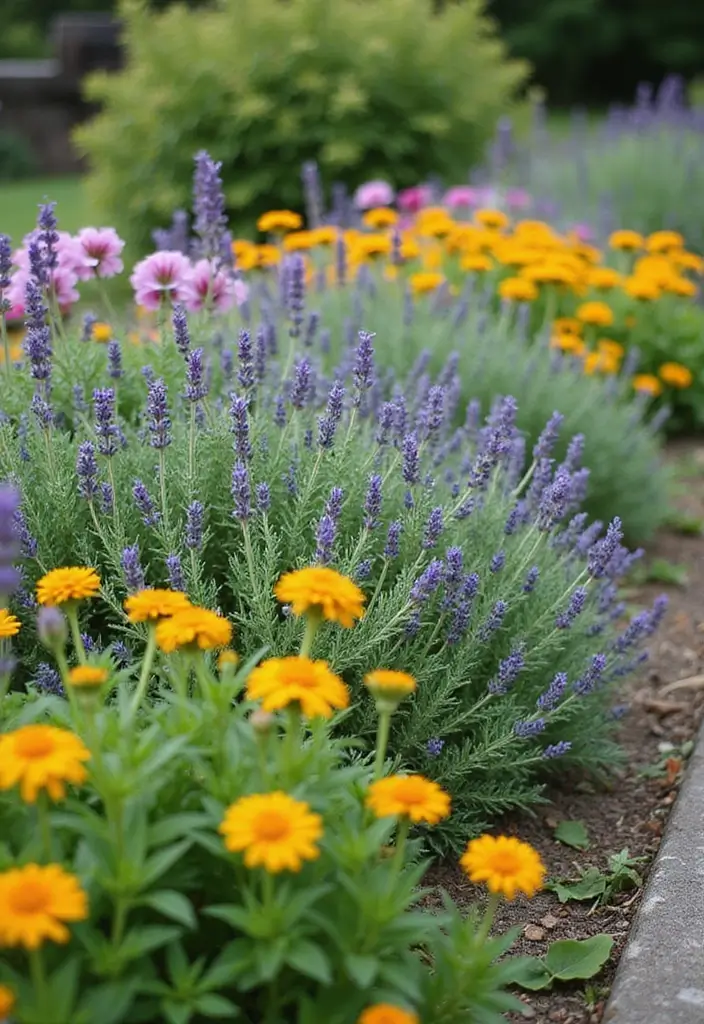
Merging herbs with flowers offers both beauty and utility to your garden border.
Consider planting fragrant herbs like lavender, thyme, and rosemary alongside colorful flowers such as calendula and nasturtiums. This combination not only saves space but also creates a delightful sensory experience. The herbs attract pollinators while providing fresh ingredients for your cooking!
Tip: Use herbs with varying heights to create a dynamic look, and consider the scent of each plant when arranging them.
Trick: Place aromatic herbs near seating areas to enhance your outdoor space with delightful fragrances.
6. Cottage Garden with Edible Flowers

Bringing edible flowers into your cottage garden adds a whimsical and practical touch.
Flowers like pansies, nasturtiums, and borage not only look beautiful but are also safe to eat. Integrate these vibrant blooms alongside traditional cottage favorites like hollyhocks and anthriscus to create a lively and eclectic border. This design allows for creativity in your cooking and garden aesthetics, making every meal a little more special.
Unique Insight: Edible flowers can also attract beneficial insects, promoting a healthier garden ecosystem.
Suggestion: Use a mix of colors and shapes to create a joyful and inviting atmosphere in your border.
7. Vertical Flower Borders

For limited space, consider a vertical flower border to maximize your gardening potential.
Using trellises or wall planters, you can grow climbing plants like sweet peas, clematis, or morning glories while adding a variety of cascading flowers at the base. This design creates a three-dimensional effect, drawing the eye upward and creating a stunning visual impact. Vertical gardens are not only appealing but can also save space in small yards or patio areas.
Tip: Use lightweight containers for your wall planters to reduce strain on your structures.
Trick: Incorporate trailing vines or add decorative pots at different heights for added interest.
8. Seasonal Rotating Borders

Consider adopting a seasonal rotating border design to keep your garden fresh and exciting throughout the year.
Select a mix of plants that bloom during different seasons, such as spring tulips, summer daisies, autumn mums, and winter evergreens. This approach not only keeps your garden looking lively but also allows you to enjoy a variety of colors and forms throughout the year. By choosing plants with staggered bloom times, you can create a dynamic display that makes your garden the talk of the neighborhood!
Insight: Plan your garden layout carefully, noting seasonal heights and colors to create a harmonious flow.
Suggestion: Experiment with plant combinations each year to discover new favorites and ensure ongoing visual interest.
A flower border garden is like nature’s canvas – rotate your blooms with the seasons to paint a fresh masterpiece all year round!
9. Border with Native Plants

Utilizing native plants in your flower border can enhance the ecological health of your garden while giving it a polished look.
Native flowers like coneflowers, black-eyed Susans, and milkweed are adapted to your local environment, requiring less water and fertilizer. This design not only provides a low-maintenance border but also attracts local wildlife like bees and butterflies. Incorporating native plants can lead to a more resilient garden that’s beautiful and beneficial.
Tip: Group plants in clusters for a more natural look, and combine various heights for visual interest.
Trick: Research your local native flora to ensure the best choices for your gardening region.
10. Curved Flower Borders

Curved flower borders can add a sense of flow and movement to your garden, creating a more inviting atmosphere.
Instead of traditional straight lines, design fluid curves that follow the landscape’s natural contours. Use a combination of tall flowers like sunflowers and shorter blooms like pansies to enhance the soft edges. Curved borders can help guide the eye and draw visitors into the garden, making the space feel larger and more engaging.
Tip: Use paths or stepping stones that mirror the curves of your flower border to create a harmonious look.
Trick: Consider planting in odd numbers for a more natural appearance and to avoid a structured feel.
11. Monochrome Flower Borders

For a refined look, consider designing a monochrome flower border that focuses on different shades of a single color.
This approach creates a sophisticated and cohesive appearance, allowing each flower type’s unique texture and shape to shine. Choose a color like lavender, pink, or yellow, and mix different varieties to create depth. This design can be stunningly elegant and make a bold statement in any garden setting.
Unique Insight: Using varying heights within the same color palette can add interest without losing the monochromatic theme.
Suggestion: Incorporate foliage in different shades of green or even some contrasting dark leaves to make your floral display pop.
12. Architectural Flower Borders

Adding architectural elements to your flower border can elevate your garden’s design, creating a striking and polished look.
Incorporate materials such as stone, brick, or wood to establish clear boundaries and support for your plantings. Elements like trellises, arbors, or garden sculptures can create focal points within the border. Pairing these with vibrant flowers like lilies, petunias, and phlox can enhance the overall aesthetic and provide a more structured appearance.
Tip: Consider the scale of your structures to ensure they complement rather than overpower your plantings.
Trick: Use contrasting materials for depth, such as pairing rough stone with soft, flowing plant forms.
Elevate your flower border garden by blending nature with structure! Use stone, wood, or trellises to frame your blooms and create eye-catching focal points. A polished look awaits you!
13. Wildlife-Friendly Flower Borders

Creating a flower border that supports local wildlife can be both beautiful and beneficial.
Consider planting a variety of flowers that attract butterflies, hummingbirds, and beneficial insects. Species like bee balm, sedum, and sunflowers not only provide nectar but also create a lively garden scene. The key is to choose flowers that bloom at different times for continuous support to wildlife while also enjoying a diverse display of colors and forms.
Insight: Incorporate plants with various heights and shapes to create a more dynamic habitat for wildlife.
Suggestion: Avoid pesticides to keep the environment healthy for your garden visitors.
14. Edging Ideas for Flower Borders

Edging can define your flower border and add a polished look to your garden.
Use materials like brick, pavers, or even low-maintenance metal to create clean lines that separate your flower bed from the lawn. Not only does this add visual interest, but it also keeps grass from encroaching into your flower space. For a more rustic feel, consider using natural stones or logs. This detail enhances the overall design while providing a practical benefit.
Tip: Choose edging materials that complement your home’s style for a cohesive look.
Trick: Consider varying the height of the edging to create a unique visual effect.
15. Drought-Tolerant Flower Borders

If you’re looking for an environmentally-friendly option, consider a drought-tolerant flower border that requires less water.
Opt for heat-loving plants like lavender, agastache, or sedum, which thrive in dry conditions. This design not only conserves water but also offers stunning blooms that stand out beautifully. Choose a mix of colors and shapes to keep the design lively and interesting, even in dry spells.
Tip: Add mulch to retain moisture and suppress weeds in your drought-tolerant border.
Trick: Group drought-tolerant plants together for a more cohesive and sustainable look.
Planting a drought-tolerant flower border not only conserves water, but it also showcases a vibrant palette of blooms. Heat-loving plants like lavender and sedum make beauty thrive, even in the driest conditions!
16. Shade-Loving Flower Borders

For those with shady areas, a shade-loving flower border can bring life and color to less sunny spots.
Select plants such as hostas, astilbes, and ferns that thrive in low-light conditions. Mixing these with flowering plants like bleeding hearts or hellebore creates a lush, inviting border that brightens up shaded corners. This approach allows you to enjoy a diverse range of textures and colors, turning a challenging area into a garden highlight.
Tip: Use lighter-colored blooms to create a focal point in darker spots.
Suggestion: Add decorative stones or garden art to create interest in areas with limited sunlight.
17. Formal Flower Borders

If you prefer a more structured and polished design, formal flower borders are the way to go.
Create symmetry and order with plants like boxwood, hedges, and annuals planted in neat rows. This design often features clipped shapes and well-defined lines, giving your garden a sophisticated appearance. Consider incorporating a central feature like a statue or fountain to draw attention and create a stunning focal point.
Tip: Regular pruning and maintenance will keep the formal look sharp and appealing.
Trick: Use contrasting colors for your annuals to enhance visual impact within the structured border.
18. Flower Borders with Ground Covers

Incorporating ground covers into your flower border can enhance texture while preventing weeds.
Plants like creeping thyme, sedum, or ajuga form a lush carpet at the base of taller flowers, creating visual interest and reducing maintenance. This design not only looks great but also protects the soil, keeping it moist and healthy. Plant taller blooms like lilies or daylilies for added contrast, making your border look fuller and more vibrant.
Tip: Choose ground covers that can tolerate your region’s climate for the best results.
Trick: Mix ground covers with flowers for a natural, flowing look that softens garden edges.
19. Rustic Borders with Natural Elements

For a more casual, rustic look, consider incorporating natural elements into your flower border.
Use logs, stones, or even driftwood to create borders that reflect the beauty of nature. Pair these elements with wildflowers such as echinacea and black-eyed Susans for an organic feel. This design can enhance the natural charm of your garden while allowing it to blend seamlessly with the surrounding landscape.
Tip: Use local materials to maintain a natural aesthetic and reduce environmental impact.
Trick: Vary the sizes of your natural elements for a more dynamic appearance.
20. Contrast Flower Borders
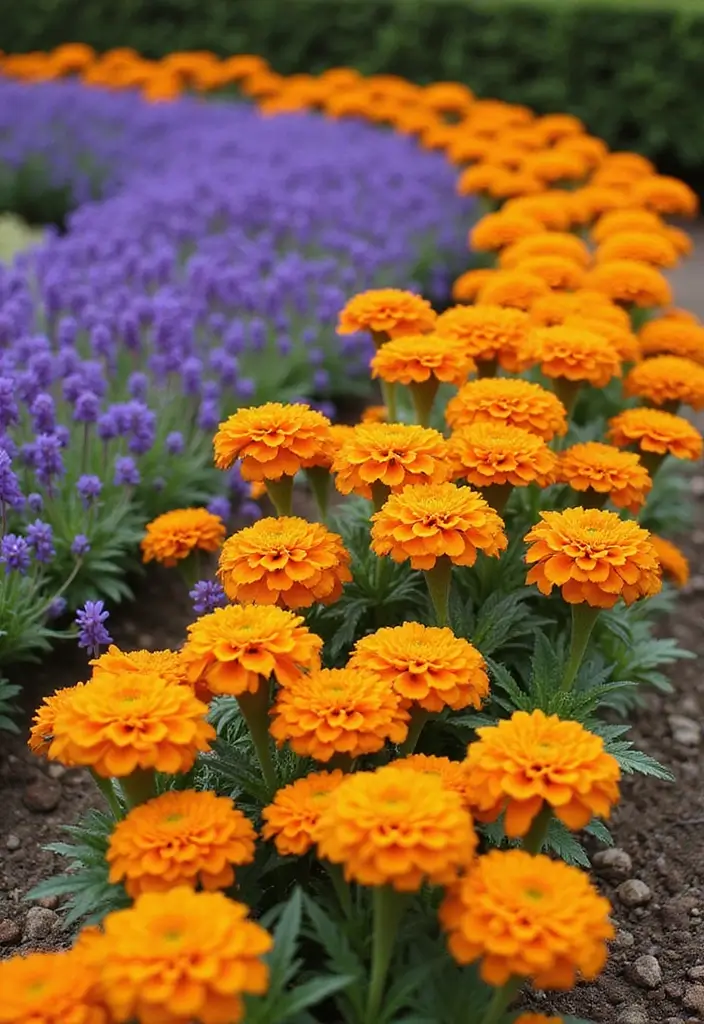
Creating contrast within your flower border can add excitement and intrigue to your garden design.
Choose flowers with strikingly different colors, such as orange marigolds against purple salvia, to create visual drama. This approach makes certain blooms pop while drawing attention to the overall design. Consider varying the heights of your plants as well, with taller varieties providing a striking backdrop for shorter blooms.
Tip: Use contrasting foliage as well, pairing dark leaves with light blooms for a sophisticated look.
Trick: Experiment with color combinations until you find the mix that feels right for your style.
21. Butterfly and Pollinator Gardens

Designing a flower border specifically for butterflies and pollinators offers both beauty and ecological benefits.
Select flowering plants like milkweed, zinnias, and lavender that attract these beneficial creatures. Create clusters of different flower types to encourage visits from a variety of species. This design not only supports local wildlife but also creates a dynamic and lively garden filled with movement and life.
Tip: Avoid using pesticides to ensure the health of your pollinator visitors.
Trick: Incorporate water sources like shallow dishes of water or pebbles for resting places for butterflies.
22. Color Theory in Flower Borders

Using color theory in your flower border design can create emotional responses and visual harmony.
Employ complementary colors like yellow and purple for a vibrant, energetic border or analogous colors like blue and green for a calming effect. This thoughtful approach to color can enhance the overall mood of your garden, making it feel either lively or serene. Arrange flowers in patterns that emphasize your chosen color scheme for added impact.
Tip: Test color combinations in smaller sections before committing to a larger design.
Trick: Incorporate some neutral colors like whites or greens to balance out bold shades.
23. Scented Flower Borders

Creating a scented flower border can enhance your outdoor experience with delightful fragrances.
Choose aromatic flowers like jasmine, roses, and lavender to create an olfactory feast. This design not only beautifies your garden but also creates a sensory experience that transforms your outdoor time. Position these plants near seating areas or walkways to maximize their fragrant effect.
Tip: Consider the flowering times to enjoy scents throughout the seasons.
Trick: Mix in some herbs like basil or mint for additional fragrance and culinary uses.
24. Pebble and Gravel Borders

Incorporating pebbles or gravel along your flower border adds texture and a modern touch to your garden.
Use these materials to create defined edges or paths that contrast beautifully with blooming flowers. Plants like sedums and succulents thrive in this type of environment, making it a low-maintenance option. This design is perfect for contemporary gardens or areas where traditional mulch might wash away.
Tip: Choose materials that complement your home and surrounding landscape for a cohesive look.
Trick: Layer different sizes of gravel for added visual interest.
25. Flower Borders with Garden Paths
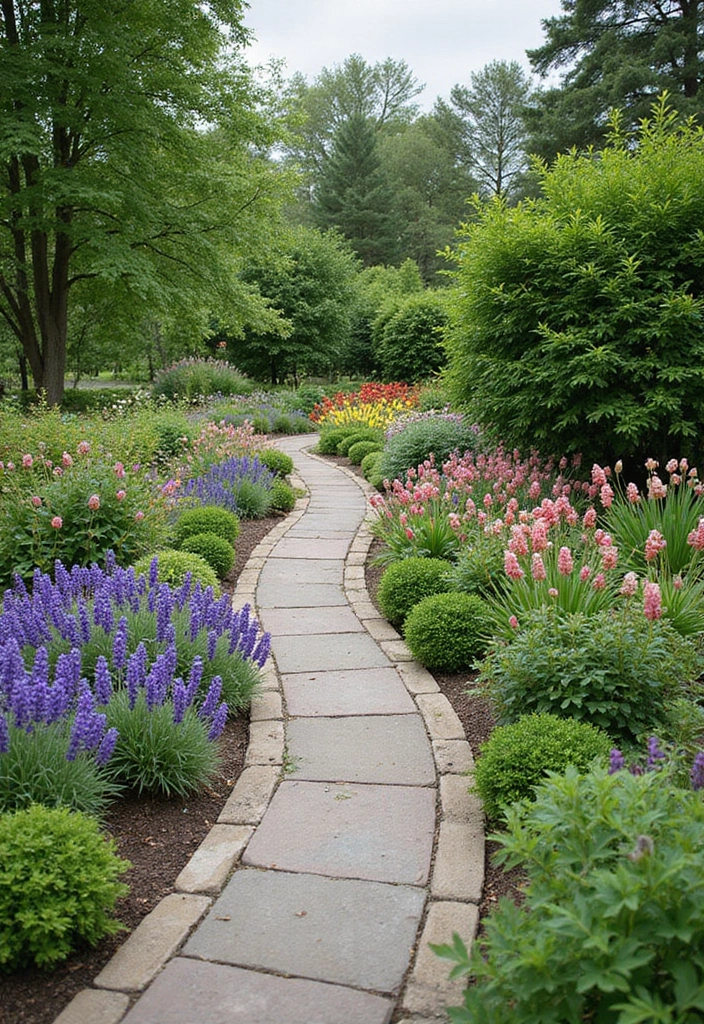
Integrating garden paths within your flower border can enhance accessibility and add visual interest.
Paths made from stone, wood, or even gravel can guide visitors through your garden while providing defined borders for your plants. This design not only beautifies but also makes it easy to care for your plants. Incorporate winding paths for a more organic look or straight lines for a modern edge.
Tip: Use materials that harmonize with your garden’s style for a cohesive appearance.
Trick: Consider adding low-profile lights along the path for safe nighttime navigation and added ambiance.
26. Rustic Fencing Flower Borders

Adding rustic fencing to your flower border can create a charming, country feel while providing structure.
Use materials like split rail wood, bamboo, or woven willow to form a natural barrier that complements your flower selections. This design not only enhances the visual appeal but also protects your blooms from wandering pets or children. Pair your fencing with climbing plants like sweet peas or clematis for added beauty and dimension.
Tip: Paint or stain your fence to match the style of your home for a seamless look.
Trick: Use the fencing to create vertical interest, allowing plants to cascade beautifully over the edges.
27. Flower Borders with Seasonal Decor
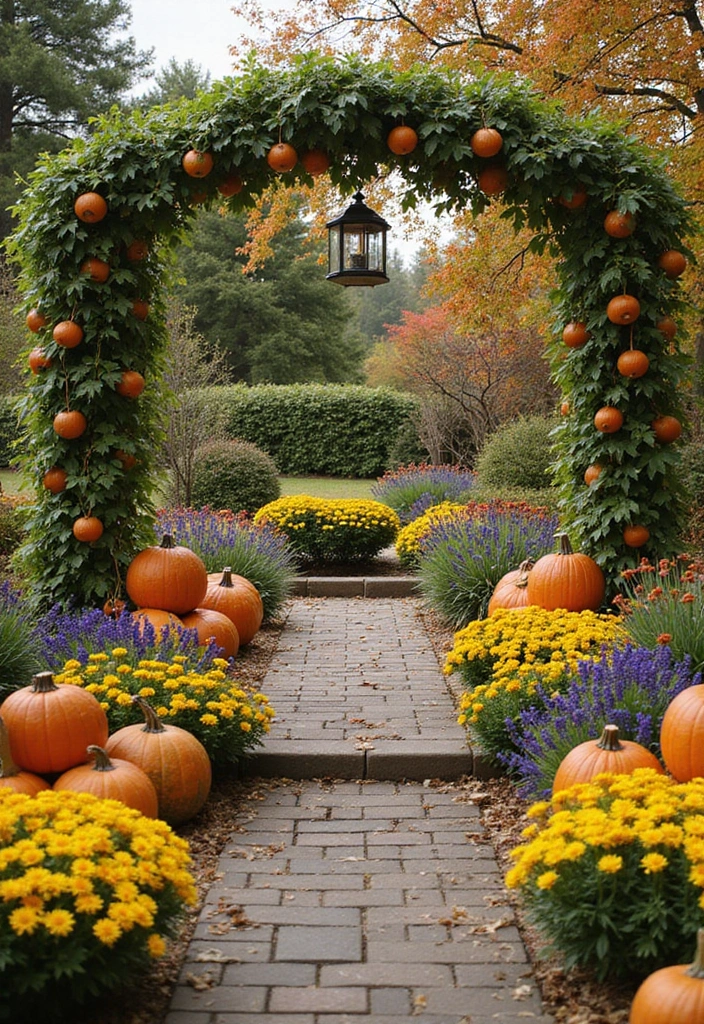
Incorporating seasonal decor into your flower border can keep your garden looking fresh and festive throughout the year.
Consider adding elements like pumpkins in the fall, lanterns in the summer, or evergreen accents in the winter. This design approach allows you to celebrate the seasons while showcasing your flowers. Seasonal decor can also enhance the overall aesthetic, making your garden a delightful space to enjoy year-round.
Tip: Use decor that complements your flower choices for a cohesive look.
Trick: Rotate decor items regularly to keep the garden feeling lively.
28. Unique Plant Pairings

Experimenting with unique plant pairings in your flower border can lead to stunning visual results.
Try combining plants with contrasting leaf shapes and colors, such as dark-leaved heuchera next to bright-green hostas, topped with colorful flowers like petunias or geraniums. This approach creates a dynamic and engaging border that draws attention and sparks curiosity. Not only does it enhance the visual appeal, but it also promotes biodiversity within your garden.
Tip: Research which plants have complementary growing conditions to ensure they thrive together.
Trick: Use odd numbers of plants to create a more natural arrangement.
Mix it up! Unique plant pairings in your flower border garden can create a vibrant tapestry of colors and shapes that not only delights the eye but also nurtures biodiversity. Let your garden be a canvas of curiosity!
29. Minimalist Flower Borders

For a modern and clean look, consider adopting a minimalist flower border design.
Focus on a limited number of plant varieties that feature striking forms or colors. This design emphasizes simplicity and elegance, allowing each plant to shine without competition. Choose a monochromatic palette or stick to a few complementary colors for a sleek appearance. Minimalism can create a sense of calm and order in your garden space.
Tip: Use natural materials for borders to maintain a clean look without adding clutter.
Trick: Keep your plants neatly pruned to enhance the minimalist aesthetic.
30. Layered Flower Borders
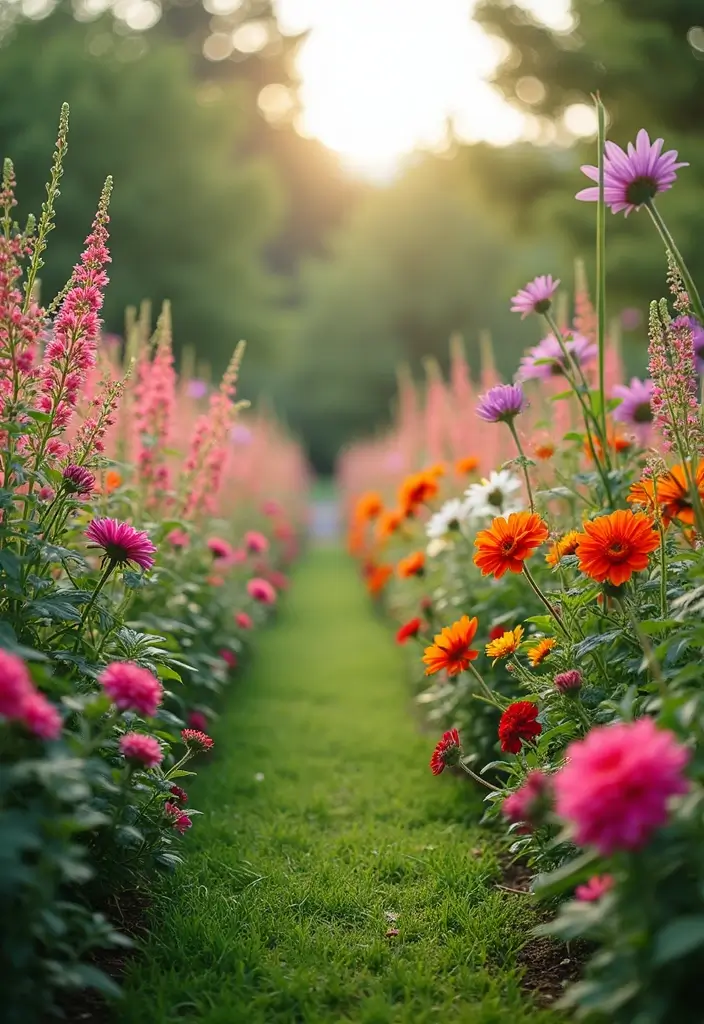
Layering plants in your flower border can create depth and intrigue while enhancing the overall visual appeal.
Start with tall plants at the back, such as sunflowers or delphiniums, followed by medium-height flowers like zinnias, and finishing with shorter varieties like marigolds or calendulas in the front. This method allows for a beautiful view from multiple angles, drawing the eye through the layers of blooms. This design not only enhances the garden’s appearance but also maximizes visual interest.
Tip: Choose flowers with staggered blooming periods to keep your border vibrant throughout the growing season.
Trick: Vary the shapes and textures of the plants for a dynamic and engaging look.
Conclusion
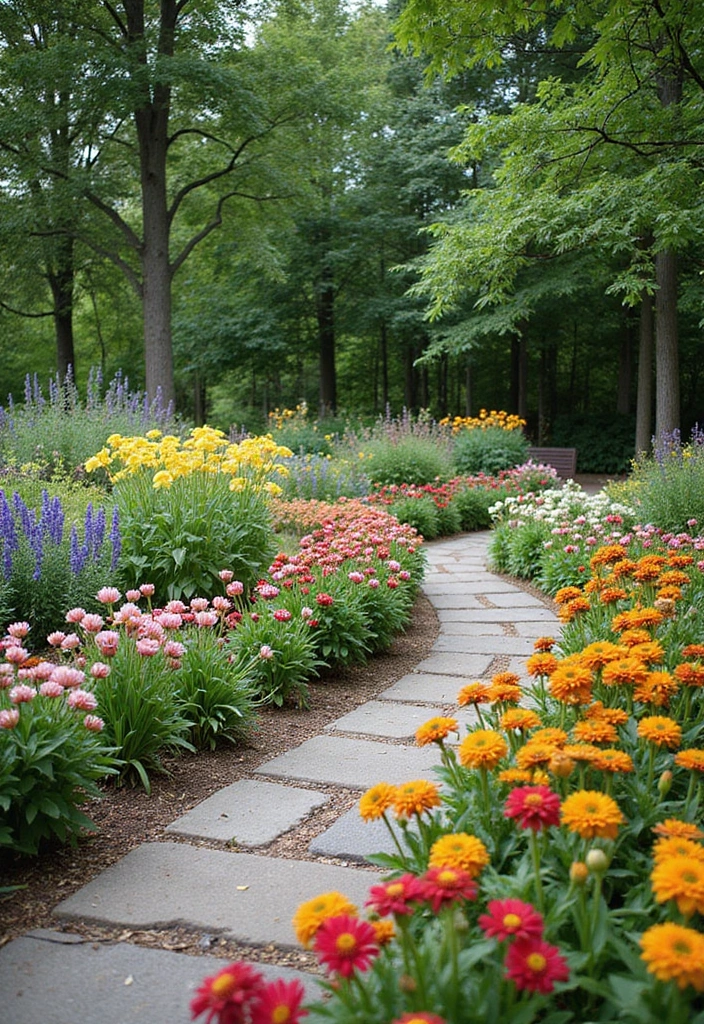
Creating a flower border garden is a fulfilling way to enhance your outdoor space while expressing your personality.
With so many ideas and design inspirations at your fingertips, you can mix and match elements to reflect your unique style and preferences. Whether you prefer a structured look or a whimsical cottage garden, these flower border ideas will surely elevate your landscaping game and bring joy to your garden. Dive into your gardening adventure and transform your outdoor space into a floral haven!
Frequently Asked Questions
What Are the Best Flowers for Creating a Colorful Flower Border?
If you’re looking to create a vibrant and colorful flower border, consider using annuals like marigolds, zinnias, and petunias. These flowers provide a stunning palette that can be refreshed each year. For a more permanent solution, mix in perennials such as coneflowers and black-eyed Susans to ensure consistent color year after year. Don’t forget to think about the bloom times so your border is lively throughout the seasons!
How Do I Choose the Right Perennials for My Flower Border Garden?
Choosing the right perennials for your flower border garden depends on your local climate and soil conditions. Start with hardy perennials like daylilies and sedum if you’re looking for low-maintenance options. Remember to consider the height and spread of plants to create a layered effect, placing taller plants at the back and shorter ones at the front for a polished look!
What Are Some Low-Maintenance Flower Border Ideas?
For a low-maintenance flower border, opt for plants like lavender, coreopsis, and daylilies. These hardy perennials require minimal upkeep while providing beautiful blooms. Additionally, incorporating ground covers like creeping thyme can help suppress weeds and enhance the texture of your border. This way, you can enjoy a stunning garden without spending too much time on maintenance!
Can I Incorporate Edible Plants into My Flower Border Garden?
Absolutely! Incorporating edible plants into your flower border is a fantastic way to combine beauty with utility. Consider planting herbs like rosemary and thyme alongside colorful flowers such as pansies and nasturtiums. This not only adds a whimsical touch but also provides fresh ingredients for your kitchen. Just ensure that the edible plants you choose thrive in the same conditions as your other flowers!
How Can I Design a Flower Border That Attracts Pollinators?
Designing a flower border that attracts pollinators is a rewarding endeavor! Choose a mix of flowering plants like milkweed, zinnias, and lavender that are known to be pollinator favorites. Aim for a variety of bloom times to provide food throughout the growing season. By creating a habitat with diverse colors and shapes, you’ll not only beautify your garden but also support local wildlife. Plus, it’s a joy to watch the bees and butterflies visit!





